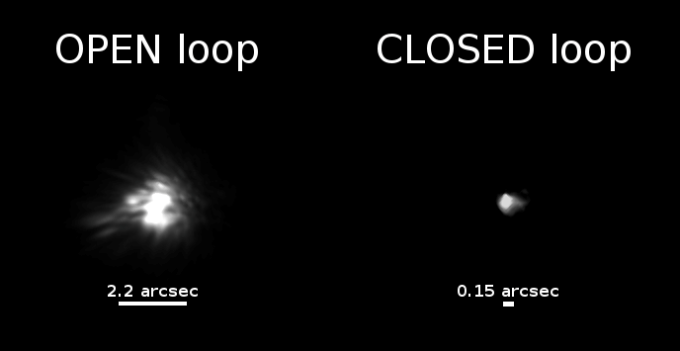Jul 27 2016
The Adaptive Optics Lucky Imager (AOLI) on the William Herschel Telescope (WHT) has obtained its first adaptive-optics closed-loop results, an important milestone in the development of this state-of-the-art instrument that aims at combining adaptive optics (AO) and lucky imaging (LI) to obtain the highest-ever resolution images at visible wavelengths from the ground.
 Images obtained during the commissioning of the AO system, AOLI, in May, 2016. Left: Open-loop image of a star whose size corresponds approximately to the full width of the brightness profile at half maximum, or 2.2 arcsec. Right: closed-loop image of the same star, this time the size of the brightness profile is only 0.15 arcsec.
Images obtained during the commissioning of the AO system, AOLI, in May, 2016. Left: Open-loop image of a star whose size corresponds approximately to the full width of the brightness profile at half maximum, or 2.2 arcsec. Right: closed-loop image of the same star, this time the size of the brightness profile is only 0.15 arcsec.
High-resolution visible imaging is currently only possible with the Hubble Space Telescope (HST). With HST's lifecycle coming to an end, it is important to investigate new observational techniques capable of providing similar resolutions from the ground. Achieving the highest possible imaging resolutions requires, however, the largest telescope apertures, and this comes at the cost of increased atmospheric distortion.
Two main techniques employed today, AO and LI, are unable to provide diffraction-limited imaging in the visible. AO is mainly used at infrared wavelengths while LI reduces in effectiveness on telescopes greater than 2.5 metres in diameter. The limitations of both techniques can be overcome by combining them to provide diffraction-limited imaging at visible wavelengths.
AOLI is being developed as a European collaboration, and combines AO and LI in a dedicated instrument for the first time. Initially designed for use on the WHT, AOLI uses a low-order AO system to reduce the effects of atmospheric turbulence plus an LI-based science camera. AOLI comprises a deformable mirror with 241 actuators, a pick-off guide-star system, a Tomographic Pupil Image Wavefront Sensor (TPI-WFS), used for the first time with adaptive optics and which provides significant sky-coverage using natural guide stars alone, and a 100-Hz loop system. Professor Lucas Labadie and his team from the University of Cologne’s Institute of Physics I were responsible for the definition and procurement of the optics, developing the scientific data reduction software, and supporting the science programs for the AOLI camera.
The AOLI team plans to fully implement AO and LI modes in the coming months, and to reach limiting magnitude ~16 for natural pick-off guide stars.